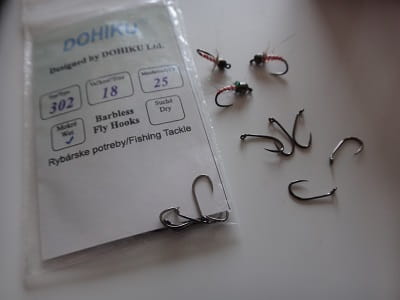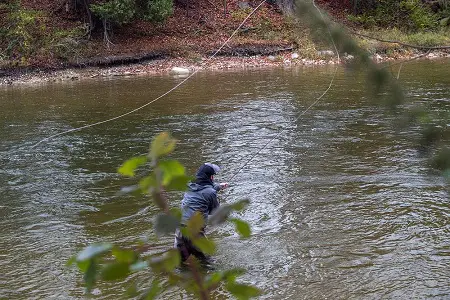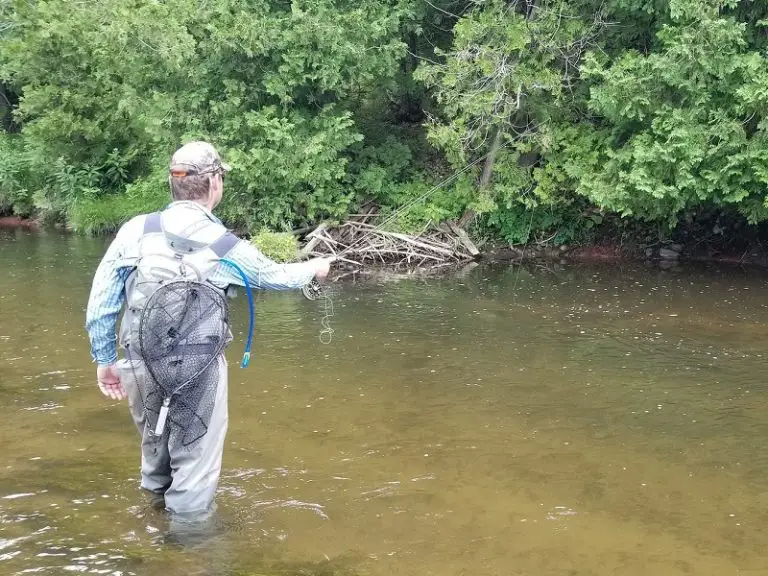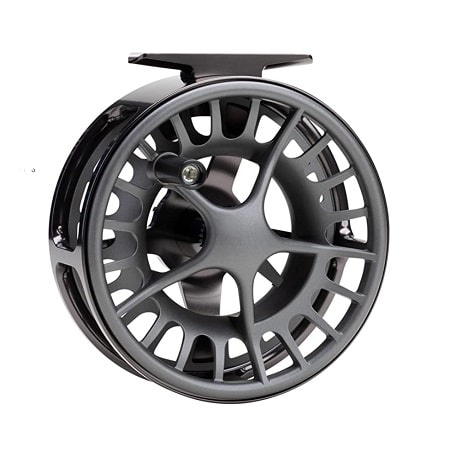Best Fly Line Backing Of 2025: Buyers Guide
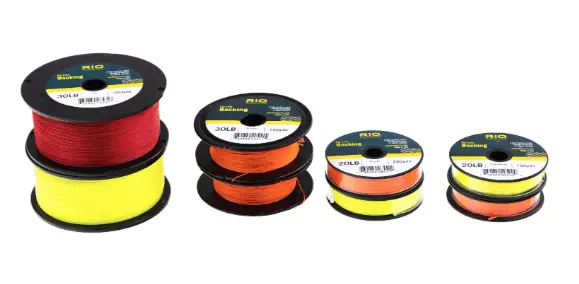
Fly line backing is a must-have on your fly reel, regardless of the species you fish for or the method you use.
As a fishing tackle store owner and guide, I’ve been able to test out many of the top backing lines, and these are the ones I recommend.
My Top 4 Fly-Line Backing Picks
There are a bunch of different ones available, and they all have their pros and cons. However, I know some of you are in a rush, so here are my top picks.
Also, this article was originally written in 2023 and was recently updated with one new and very popular fly line backing that you should consider. You can see it below.
- The Best Dacron Backing: Rio Dacron Backing
- The Best Gel Spun Backing: Cortland Gel Spun
- The Best Fly-Line Backing For Trout: Rio GSP Dacron Backing
- The Best Fly-Line Backing For Steelhead: PowerPro Hollow Ace Backing
What Is Fly Line Backing and Why Do You Need It?
Fly line backing is a type of super-thin braided fishing line that goes between the fly reel and your fly line. I always have good fly-line backing on all my fly reels.
Why Use Fly Line Backing?

There are two purposes for using backing. It is used to fill some space on the spool of the reel so that the reel is full after I add the fly line and leader. This increases the uptake of my fly line when reeling it in.
The second reason is that since most fly lines are only 90 feet long, the backing adds a safety buffer, which means it allows big fish to run an extra distance when fighting larger game fish such as salmon and steelhead, or saltwater fish.
These large fish can sometimes make runs of 200+ feet, and without any backing, I could lose my very expensive fly line.
The Two Types Of Backing Lines
There are two main types of backing that I use and recommend.
Dacron: Pros and Cons
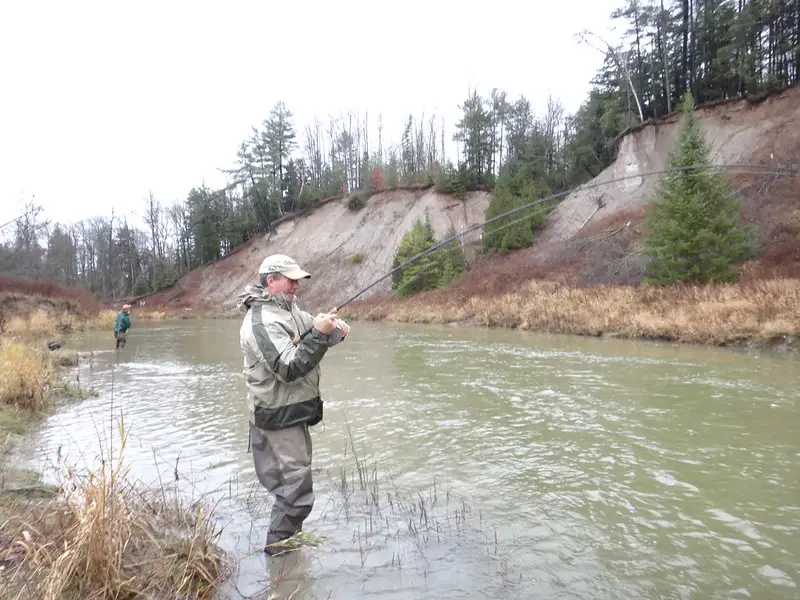
Dacron is the traditional fly-line backing material that has been used for over 35 years. It is usually made from a combination of polyethylene and cotton.
It is strong, durable, and abrasion-resistant, and it usually lasts over ten years.
Some anglers claim that the drawback to Dacron is that it can absorb water rather quickly, which could add extra weight to the fly rod setup, especially if I dunk my reel. However, my clients and I have done this many times, and the extra weight is almost unnoticeable.
The only real issue with absorbing water is when saltwater fishing, since saltwater has a tendency to damage things.
A pro and a con to Dacron is that it is a bit thicker than other backings.
The pro to this is I don’t need as much to fill up the spool, which is great when dealing with smaller fish that won’t make huge, long runs.
The con to this is when dealing with big fish, I want as much backing on the reel as possible.
A key advantage of Dacron is that it offers more stretch than other materials, making it a great choice for newer anglers who haven’t yet learned the proper technique of fitting big fish and setting fly reel drag properly.
Additionally, due to its durability and abrasion resistance, Dacron will last longer than most other materials.
Gel Spun Backing: Pros and Cons
Gel spun backing is a newer type made from an ultra-strong, ultra-light material. It has a much higher breaking strength than Dacron and is also less likely to absorb water, making it ideal for use in saltwater conditions.
The major drawback to gel-spun backing is that it can be more expensive than Dacron and tends to be less abrasion-resistant.
A major advantage is that it is thinner, so I am able to pack on a lot more backing onto the reel, which is great when fighting big fish that can run more than 200 feet.
Another benefit is that it is so thin, it does not cause as much drag under the water when a fish is running far or when a current is involved. The extra drag can create more tension and potentially break my tippet.
How Much Backing Should Go On A Fly Reel?
The amount of backing I put on a fly fishing reel depends largely on the size of the reel. I’ve heard anglers say things like “for freshwater applications, about 150 yards of 20-pound Dacron is sufficient, and for saltwater fishing, 250 yards or more of 30-pound Dacron is recommended”.
However, I don’t agree with general lengths since I might only get 50 yards on a 3-weight reel and 300 yards on a 9-weight reel. So, for me, I stand by recommending putting on the maximum amount the reel will take.
I ensure that I leave enough room so that the fly line and the fly leader are able to fit on the reel. When everything is on the reel, the reel should be full, but not so full that it impedes the turning of the reel.
When in doubt, check the manufacturer’s recommendations for the specific reel you are using.
Additionally, the type of fly line I use can also impact how much backing should go on the reel; for instance, floating lines require more backing than sink tip lines. Some fly lines, such as Spey lines are thicker, so less backing might be required.
The Best Dacron Backing
These are my recommended fly-line backings based on my 37 years of experience.
Rio Dacron Backing
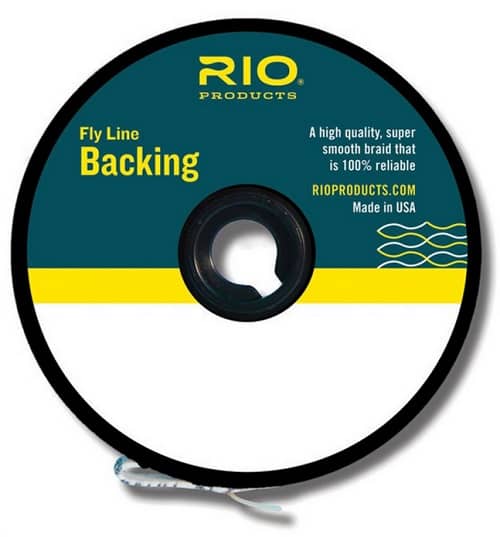
Rio Dacron Fly Line is a great choice because it is strong and abrasion-resistant, perfect for saltwater fishing conditions.
It also has incredible knot strength and seems to last forever, which allows a fly fisherman to put it on and forget about it.
Lastly, the bright color ensures that I can easily see the transition when it comes out, and it helps with locating it when it’s in the water.
Guide Tip: Fly line is expensive, so I make sure I use the right knot to attach the backing to the fly reel and the backing to the fly line. And, if a large fish takes all my fly line out and I am getting close to the end of my backing, I tighten the drag so the fish doesn’t take my entire fly line and backing.
Best Small Diameter and All-Purpose Dacron – NEW
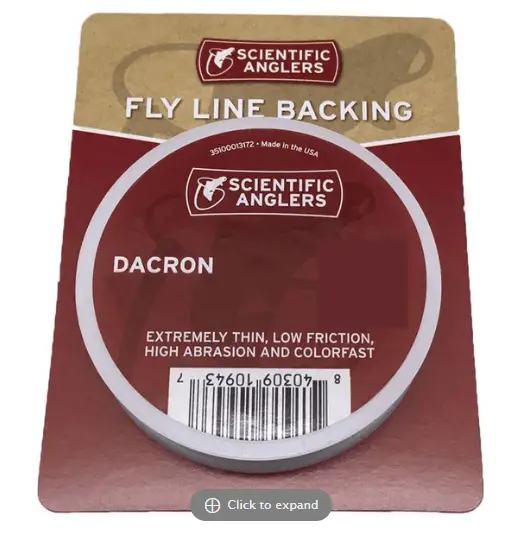
I’ve been using the Scientific Anglers Dacron Fly Line Backing as my go-to, all-purpose backing for a variety of freshwater species, and it’s been rock solid.
The first thing I noticed was its smaller diameter, which means I can fit more line on my reel without giving up strength.
That’s thanks to the advanced 3M technology behind it — they’ve managed to keep it thin without sacrificing durability.
Check it out – HERE
The Best Gel Spun Backing is Cortland Gel Spun Backing
I think I bought my first spool of Cortland backing the year it came out. I found it to be much thinner than Dacron, and I was able to get a lot more of it on steelhead and salmon reels.
The unique composition of the Cortland Gel Spun line makes it the perfect backing for fly fishing large fish.
Its low-diameter core gives me more line capacity and reduces drag when it’s in the water, enabling me to fight large fish better.
Plus, it offers superior knot strength, which helps ensure my connections are secure.
Additionally, its abrasion resistance is ideal when fishing rivers with lots of rocks.
The lower stretch factor also means that I can feel the fish better however, with lower stretch, there is more of a chance of breaking tippets.
All these features make this line ideal for anglers who want maximum reliability and performance in their setup.
One downside that I have noticed is that because it is so thin, when the fish is running fast it can cut my fingers or even burn my fingers. Therefore, I tell my clients to keep their hands off the line when the fish are running.
Cortland Overall Fly Backing is available in 30, 50, and 80 lb weights. The gel spin fibers are super high strength. The high-visibility white, yellow, pink, and blue colors give anglers plenty of options to choose from.
Orvis Gel Spun backing is another good option that I have been testing and liking.
The Best For Trout Is Rio Dacron Backing
Rio Dacron Backing is an excellent choice for trout fishing due to its durability and strength. It’s a versatile and strong line well-suited for freshwater trout fishing.
Since trout do not pull out a lot of backing, I don’t need as much on the reel, and Dacron feels the reel faster. For this reason, all my trout reels have Rio Dacron or Orvis Dacron on them.
I like that it has the right amount of stretch so I can use it to make blind splice loops.
Also, the line’s low memory and remarkable strength-to-diameter ratio make it easier to spool without getting tangled or knotted.
Another great thing is the sheer number of colors to choose from! I like the vibrant chartreuse that helps me see my line. It comes in 100-yard, 200-yard, or 300-yard spools, but that’s it as far as the lengths go.
All these features, combined with its great value for money, make Rio Dacron backing an ideal choice for trout anglers. For a full specification of this product, please visit.
The Backing For Steelhead Is Power Pro Ace
I’ve recently started using PowerPro HollowAce backing because another guide recommended it. I’m still testing this out since it is a relatively new product and new to me, but so far so good.
PowerPro Hollow Ace backing features an ultra-thin microfiber construction that enables me to put more on a larger capacity spool while keeping weight to a minimum. The ultra-long 500-yard capacity means I can outfish even the strongest fights.
The 40 lb weight tolerance is great for handling the biggest fish.
Its white color is great for most light conditions. Overall, I think it’s a solid choice.
The Backing For Salmon
When I’m fishing for salmon, I now find myself returning to the PowerPro Hollowace Backing time and time again.
Because it comes in such large spools, I can get more on my large fly reels.
The Best Fly Line For Saltwater Fishing and Big Fish
PowerPro Hollow Ace backing is the perfect choice for saltwater fishing and catching powerful fish such as tarpon, bonefish, and whatever else bites the line in the ocean.
Its braid construction increases abrasion resistance, while its hollow core design provides extra strength and durability.
The line is made with Enhanced Body Technology, which has an outstanding strength-to-diameter ratio. Best of all, it doesn’t absorb much water, and it lasts in salt water!
Does The Color Of Fly Line Backing Matter?
One of the questions my clients ask me is “Does the color of the backing matter, or make a difference. And the short answer is no.
This is because for most fishing, the backing is rarely used, and it’s rarely ever in the water, so it’s not likely to ever be seen by a fish.
Now, the color of your fly line DOES matter, so be sure you check out my articles on the Best Fly Lines For Trout: Guide Recommended, steelhead, and salmon fishing, found on THIS PAGE.
Tight Lines
Graham

